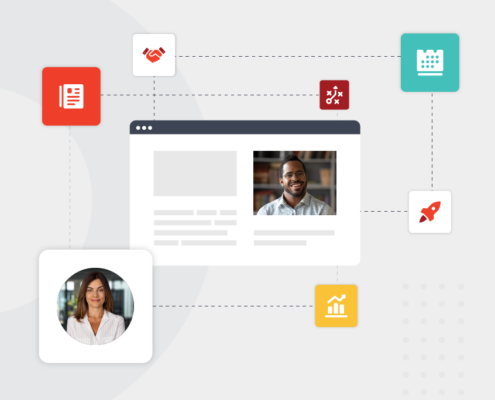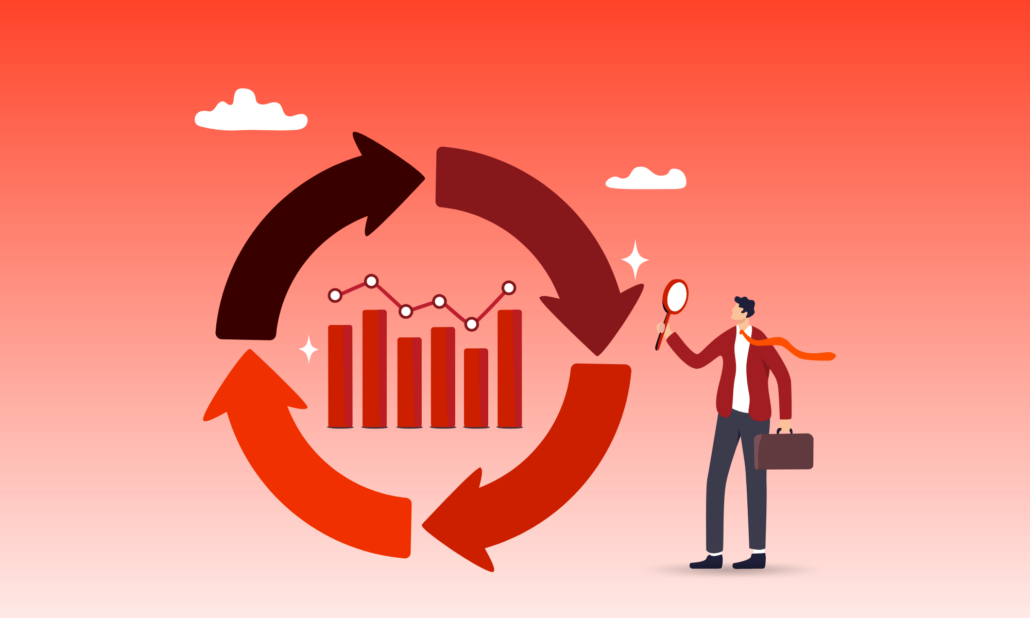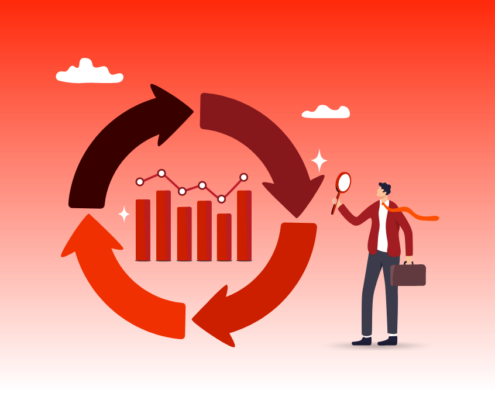

Picture this—you’re a skilled sales professional, an expert in piquing the interest of potential buyers and converting them from prospects into leads. However, you can’t quite get them to take the leap of faith and invest in your company’s product or service, resulting in incredibly lengthy sales cycles.
While you might be (or have) a team of exceptional salespeople, sales cycle times from introduction to close is only getting longer, and there’s little hope of shortening it. We get it—it’s a tale as old as time. However, all hope isn’t lost. Understanding the sales cycle of your business and the buying habits of potential buyers is key to reducing it and meeting potential buyers where they’re at in the buying cycle.
In this blog, we’ll cover the following topics:
What Is the Sales Cycle?
A sales cycle is the process your company goes through from the initial point of contact with a prospect to the moment of making the sale. It’s the journey that both your business and your prospective client embark on, beginning with identifying a lead and ending with closing the deal.
Understanding your sales cycle is paramount to your business growth and sales development. By identifying each stage in your sales cycle, you can pinpoint areas for improvement, plan effective sales strategies, and better forecast sales. This process is crucial for the scalability of your business. It enables you to make predictable, strategic, and data-driven decisions based on the trends identified in your sales cycle.
It’s important to remember the nature and length of the sales cycle can significantly vary based on whether your business operates in a business-to-consumer (B2C) or a business-to-business (B2B) setting.
Difference Between B2C and B2B Sales Cycles
B2C sales cycles are typically shorter, more impulsive, and require only one decision-maker. For example, think about when you’re shopping for a new pair of shoes or a book. More often than not, you usually don’t spend weeks pondering the decision—you see the product, like it, maybe compare it with a few others, and buy it. The decision-making process is swift because it’s personal and direct.
On the other hand, B2B sales cycles can often feel like running a marathon. They’re longer, involve more steps, and require approval from multiple decision-makers. In B2B transactions, companies are often dealing with higher stake purchases that necessitate a more detailed evaluation, multiple discussions, and negotiations before reaching a consensus. It’s not just about liking a product or service—it’s about ensuring it fits the company’s needs, budget, and long-term goals.
While B2C and B2B sales cycles have unique attributes and challenges, the common thread is the importance of understanding your specific sales cycle. By breaking down and analyzing each stage, you can optimize your sales process, improve customer experience, and generate more revenue for your business.
Understanding your company’s sales cycle is important, and so is understanding a decision-maker’s journey through the sales funnel. Read our blog here to learn about the B2B sales funnel and how it can lead to a reduced sales cycle.
What Are the Seven Stages of the Sales Cycle?
As the name suggests, a sales cycle involves various stages that sales teams must follow to move prospective businesses down the sales pipeline effectively.
Here are the seven stages of the B2B sales cycle:
Stage 1: Strategic Prospecting
Strategic prospecting is the foundation upon which a successful B2B sales cycle is built. Think about it like setting out on a journey—you can’t embark without knowing your destination. And in the sales world, your destination is your prospects, the potential buyers who could benefit from your product or service.
The essence of strategic prospecting lies in its name; it’s about being deliberate and strategic in identifying and approaching potential customers. Not every person or business is going to align with your product or service, and that’s okay. The objective is to focus on the people who are a good fit. It involves understanding your ideal customer profile, their pain points, and how your product or service can solve their problems.
There are numerous ways to find these prospects, and the method you choose will largely depend on your budget, resources, and the nature of your business. Here are some ways to prospect potential buyers strategically:
- Purchase third-party prospect lists: Third-party list providers like ZoomInfo and D&B Hoovers is great for getting a significant number of prospects in the sales pipeline. However, while it may provide you with a high volume of potential leads, it’s essential to ensure the list is high-quality, requiring sales reps to follow up and qualify (which we’ll get more into later).
- Ask for referrals from current clients: This approach leverages the trust and satisfaction you’ve built with your existing customers to find new ones. It’s a testimony to the value you deliver and can often lead to highly qualified prospects.
- Use LinkedIn Sales Navigator: This tool is a goldmine for B2B companies, offering advanced search and filter options to pinpoint potential clients based on industry, job role, location, and more.
Strategic prospecting isn’t a one-time task—it’s a continuous process. Just as a farmer regularly sows seeds to reap a harvest, you need to continually replenish and nurture your prospect list to maintain a healthy sales pipeline.
For more insight into how to have an effective B2B sales prospecting strategy, read our blog here.
Stage 2: Connect With Prospects
Connecting with prospects, the second stage of the sales cycle, is where the rubber meets the road. It’s time to transform your list of prospects into meaningful conversations, and your sales development representatives (SDRs) play a pivotal role here.
The methods of connecting can vary from cold calls, sales emails, social media outreach, or even office drop-ins. However, the goal remains the same—to initiate contact and build rapport with the individuals who hold the purchasing power within their organizations.
Reaching out to the right person is crucial. If you’re speaking to someone who lacks the authority to make purchasing decisions, you’re unlikely to progress in your sales journey. Therefore, identifying and connecting with decision-makers is a key aspect of this stage.
If your SDRs don’t have a direct line or a specific name, they shouldn’t be discouraged. Instead, they can leverage gatekeepers who are the individuals who control access to the decision-makers. These gatekeepers could be receptionists, assistants, or other staff members who can provide insights about the right person to contact. The art of dealing with gatekeepers is an essential skill for SDRs, requiring the right tone and set of questions.
If your team is still finding it challenging to identify or connect with decision-makers, sales prospecting tools can come to the rescue. There are platforms like ZoomInfo or D&B Hoovers that can provide valuable information like names, job titles, phone numbers, and even email addresses. These tools can arm your SDRs with the information they need to reach out directly to decision-makers, thereby increasing their chances of success.
Need help building a list of outbound prospects? Read our blog here to learn where to start with prospect list building.
Stage 3: Qualify Leads
Lead qualification, the third stage in the sales cycle, is akin to the filtering process in a funnel. It’s all about separating the wheat from the chaff, ensuring your SDRs are investing their time and energy in leads with genuine potential for business closure.
A lead, or prospective business, becomes qualified based on two types of criteria: sales qualification and marketing qualification. It’s like a two-factor authentication process—both criteria need to be met for a lead to be considered completely qualified and ready for a sales meeting.
Sales qualification relates to the objective, tangible aspects of the prospect. It’s about gauging whether the prospective business has the capacity to become a customer. Factors could include the number of employees, revenue generation, industry, and more. Basically, it’s about verifying whether the prospect fits the mold of your ideal customer profile (ICP).
Marketing qualification is a bit more subjective. It deals with the level of interest a prospect has in your product or service and their authority to make a purchase decision. It’s about assessing whether they’re genuinely interested in what you’re offering and if they’re in a position to act on that interest.
A key thing to remember is that these qualifiers will vary from business to business. What works for one may not work for another. That’s why it’s crucial to define what a qualified lead looks like for your business, taking into account both sales and marketing criteria.
When practicing outbound lead generation, prospects often meet the sales qualification criteria before they’re considered marketing qualified leads. This means they fit your ICP but may not yet be ready to progress further in the sales cycle. And that’s okay. Just like a tiny seed takes time to sprout, leads may need time before they’re ready to move forward.
That’s where the importance of lead nurturing comes in. If a sales qualified lead isn’t ready to schedule a meeting or take the next step, it’s not a signal to abandon the lead. Instead, it’s a cue to continue nurturing the relationship, providing value, and maintaining contact until they’re ready to move forward.
Lead qualification is a vital stage in the sales cycle because it ensures efficiency and effectiveness in your sales efforts. By focusing on leads that meet both sales and marketing qualifications, you’re ensuring your SDRs are chasing the best leads—the ones with real potential for business closure.
For complete insight into the lead qualification process, read our blog here.
Stage 4: Hold a Sales Pitch
This stage is all about presenting your solution to the prospects who have passed through the qualification process.
A sales pitch is not just a presentation; it’s a golden opportunity to showcase how your product or service can solve the prospect’s problem or enhance their operations. It’s your chance to transform interest into desire and intention into action.
In this stage, sales and account executives need to clearly articulate the unique value proposition of your product or service. They should highlight not just the features but the benefits—the real, tangible advantages that the prospect can gain from choosing your offering.
However, a great sales pitch isn’t just about talking; it’s about listening, too. It should be a two-way conversation where the prospect feels heard and understood. By engaging the prospect in a dialogue, you can tailor your pitch to address their specific needs and concerns, making it more personalized and effective.
Visual aids, like presentations or product demos, can also be instrumental in enhancing your pitch. They can help to illustrate your points more vividly and make your offering more tangible to the prospect.
Not sure where to start with creating a B2B sales presentation? Read our blog here to learn how to build a sales slide deck that converts opportunities into customers.
Stage 5: Overcoming Sales Objections
Even the most qualified leads may have reservations or objections that could stall or even derail the sales process. Here are some reasons why prospects may object your sales pitch:
- Financial objections: Prospects might express concerns about the cost of your product or service, especially if there are less expensive alternatives in the market. Your sales team must articulate the value your solution provides, demonstrating that the benefits and potential return on investment outweigh the cost.
- Timeline misalignment: Perhaps the prospect agrees that your solution would be beneficial, but they don’t believe the timing is right. They might think it’s too disruptive to implement now, or they have other priorities. In this case, your sales team can emphasize the long-term benefits and potential cost of delay. Offering flexible implementation plans or support during the transition can also alleviate these concerns.
- Complacency or fear of change: If prospects are comfortable with their current solution or process, they may resist switching, even if your offering is superior. Addressing this objection requires building trust, demonstrating the ease and benefits of transition, and potentially offering trials or testimonials from satisfied customers.
Overcoming sales objections is not about dismissing or minimizing the prospect’s concerns but about understanding and addressing them. It requires empathy, active listening, and problem-solving skills. It’s a chance to further demonstrate the value of your offering and to reassure the prospect that choosing your solution is the right decision.
If you want more insight into the most common sales objections (and how to overcome them), read our blog here.
Stage 6: Closing the Deal
We’re entering the final stages of the sales cycle—closing business. Once your account executives have presented sales opportunities with a pitch deck customized to their needs, it’s time to wait for them to make their decision.
While this stage can be a waiting game, your account executives must follow up after the sales meeting to learn when they’ll come to a conclusion. During the sales meeting follow-up, your account executives should ask when they’ll make a financial decision on whether to take you up on your offer.
Once they give them a date, they must follow up at that time to ensure all your sales and marketing team’s hard work doesn’t fall through the cracks.
Closing the deal is a delicate balance of persistence, patience, and proactive communication. It’s one of the final hurdles in the sales cycle, one that brings you to the finish line, transforming a qualified prospect into a valuable customer.
Stage 7: Implementing and Onboarding the New Client
Now that the deal is closed, it’s time to shift gears from selling to servicing. The focus now is on implementing the new client, ensuring they derive maximum value from your product or service, and securing their satisfaction and loyalty.
Implementing a new client is more than just onboarding them onto your platform or delivering your product. It’s about building a strong, mutually beneficial relationship that will stand the test of time. It’s about demonstrating that the trust they placed in you by choosing your offering was not misplaced.
During this stage, your account executives play a crucial role in facilitating a smooth transition for the new client. They should be on hand to answer any queries, provide necessary training or support, and help the client navigate any initial hurdles. The aim is to make the client feel valued and supported, reinforcing their decision to choose your offering.
But the learning doesn’t stop here. This stage also provides a valuable opportunity to gain insights into the prospect’s journey. Account executives can engage in a feedback session with the new client, asking about their experience with your sales process and what could have made it more seamless for them.
Feedback like this can provide invaluable insights into potential areas for improvement in your sales cycle. Did they feel any step took longer than necessary? Were there any points of friction or frustration? Understanding these can help you streamline your process, accelerating the sales cycle for future prospects.
The final stage of the sales cycle is not just a conclusion but a bridge to future sales and a stronger client relationship. It’s about celebrating the successful closure, delivering on your promises, and setting the stage for ongoing success.
Shortening the sales cycle is no easy task, but it can be made easier with a reliable outsourced lead generation partner. Contact the business growth experts at Abstrakt to learn how our services can help you reduce your sales cycle and generate more revenue!
How to Reduce the Amount of Time a Prospect Spends in the Sales Cycle
While the sales cycle for B2B companies is often much longer than for B2C, there are some techniques your SDR and marketing teams can follow to expedite the process. Here are some of the best B2B sales techniques your team can follow to shorten the sales cycle:
Invest in Robust Sales Training
Your sales cycle is only as good as how you train your sales team. It’s important to find the tough spots in the cycle where your team struggles and implement the right training. This can help your sales cycle get better, and it can also give your company an edge over the competition. After all, when your sales team wins, everyone wins!
Keep a Record of Data and Use It to Advance Your Strategy
If you want to reduce the amount of time a prospect or lead spends in the sales cycle, it’s essential to keep a record of past sales campaign data and use it to explore areas of improvement. Having a well-kept sales campaign requires a lot of trial and error, and some strategies and tactics are more impactful than others. Using past sales campaign data from each step of the sales cycle is crucial to see where there may be a disconnect between you and your target audience. This empowers you and your sales team to make adjustments where they seem fit, accelerating the amount of time a potential buyer spends in the sales cycle.
Distribute Routine Lead Nurturing Emails
Lead nurturing emails should continuously provide the qualified prospect with value and guide them closer to the end of the sales cycle. Before pressing “send,” you must consider the prospect’s stage of the sales cycle and what they may be interested in learning more about. For example, it may be worth directing them to a relevant blog post or your social media profiles if they’re in the awareness stage. However, if they’re toward the end of their buying cycle, you should have call-to-actions (CTAs) encouraging them to schedule a meeting with your company.
Make Warm Phone Calls
Warm calls are best when a potential buyer is in the consideration stage of the buyer’s journey. If a prospect says they don’t reevaluate their contracts for another nine months, making a warm call three months later wouldn’t do your SDRs or the prospect any good. This is what makes lead nurturing emails so effective because you can continuously provide top-of-mind awareness while also being considerate of their timeline.
Send Relevant Content to Leads on LinkedIn
LinkedIn is an amazing social media platform for reaching qualified prospects in the sales pipeline. It’s a professional platform designed to network with like-minded people in your field of work. Through LinkedIn, sales reps can share relevant content marketing materials to help progress their journey down the sales funnel.
Develop Segmented Buyer Personas
While your target audience may stay consistent throughout your business, the buyer personas of prospects in the sales pipeline may vary from person to person. Since there are various buyer personas to be aware of in your market, your sales and marketing teams must segment them so they can continuously send them the right content to pique their interest and engage with them through platforms they’d engage with most.
Respond to Inbound B2B Leads…Fast
Many B2B sales and marketing teams struggle with getting results from inbound lead generation because they don’t respond to inbound leads promptly. When an interested user converts themself into an inbound lead, your SDRs must react quickly so they don’t find another product or service provider in the meantime. The quicker your business growth teams respond to potential sales opportunities, the more likely they will convert them into closed business because they’re actively searching for answers.
Key Takeaways
Reducing the sales cycle is no easy task, but it can be done as long as you’re willing to invest the work and dedication. Sales cycle lengths look different for every company depending on their target market, the industry they serve, and the lead generation strategy they have in place. And you don’t have to do it alone.
If you’re ready to rev up your sales cycle, Abstrakt’s lead generation services are here to help. At Abstrakt, we work with small to medium-sized businesses across the nation, taking steps one through three of the sales cycle process out of the equation, empowering your company to speed up the sales cycle and save your team time and money.
When you’re ready to get started, contact the lead generation experts at Abstrakt!




